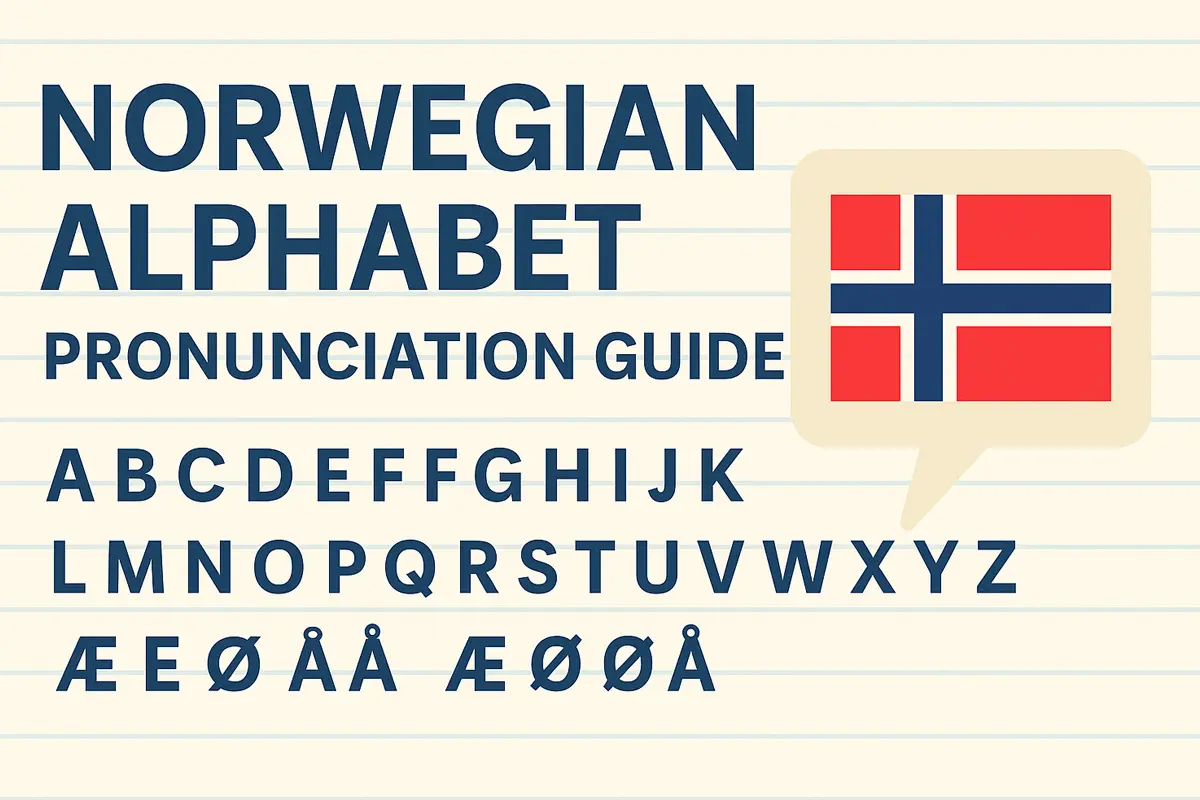
If you’re asking about Norwegian alphabet pronunciation, here’s the quick answer:
The Norwegian alphabet has 29 letters — the familiar 26 English ones plus Æ, Ø, and Å. Most consonants sound similar to English, but vowels can differ. For example, Æ sounds like the “a” in cat, Ø is similar to the French eu, and Å sounds like the “aw” in saw.
This pronunciation guide breaks down each letter, gives you examples, and explains the short vowels, consonants, and unique sounds you’ll need to master if you want to sound natural in the Norwegian language.
Table of Contents
Open Table of Contents
- 1. Overview of the Norwegian Alphabet
- 2. Vowels and Their Pronunciation
- 3. Consonants and Special Sounds
- 4. The Three Extra Letters: Æ, Ø, Å
- 5. Short vs. Long Vowels
- 6. Stress and Sentence Structure
- 7. Bokmål vs. Nynorsk Pronunciation
- 8. Mini Pronunciation Guide with Examples
- 9. FAQ
- 10. Final Thoughts
1. Overview of the Norwegian Alphabet
The Norwegian alphabet is similar to English, with 29 letters:
A B C D E F G H I J K L M N O P Q R S T U V W X Y Z Æ Ø Å
- C, Q, W, X, Z → appear mostly in loanwords like camping or pizza.
- Æ, Ø, Å → unique vowels that English speakers must practice.

Because Norwegian is a phonetic language, words are often pronounced as they’re written, making it easier for English speakers to learn. You can also check our interacive Norwegian Pronunciation table
2. Vowels and Their Pronunciation
Vowels make up the core of Norwegian pronunciation. There are nine main vowels: A, E, I, O, U, Y, Æ, Ø, Å.
| Letter | Sound | Example |
|---|---|---|
| A | like “a” in father | mann (man) |
| E | like “e” in bed | pen (pretty) |
| I | like “ee” in see | fisk (fish) |
| O | like “oo” in wool or “o” in pot | bok (book) |
| U | like “oo” in flute | hund (dog) |
| Y | like German “ü” | ny (new) |
| Æ | like “a” in cat | bær (berry) |
| Ø | like French “eu” | øl (beer) |
| Å | like “aw” in saw | år (year) |
💡 Tip: Vowel length matters. Hun (she) vs. hunn (female animal) change meaning depending on short vs. long vowels.
3. Consonants and Special Sounds
Most Norwegian consonants are close to English, but watch these differences:
- J = y (like “yes”) → jul (Christmas)
- K before i/y = h-sound → kjøtt (meat)
- Sk before i/y = sh-sound → ski (ski)
- G sometimes softens before i/y → gi (give)
Silent letters:
- Final -d often silent (hund → sounds like hun).
- Hv- pronounced like “v” (hva → va).
4. The Three Extra Letters: Æ, Ø, Å
These are the distinctive Norwegian vowels:
- Æ (æ) → “a” in cat. Example: nær (near).
- Ø (ø) → “u” in French tu. Example: brød (bread).
- Å (å) → “aw” in saw. Example: gå (go).
They are essential for correct Norwegian pronunciation — mispronouncing them can change meaning.
5. Short vs. Long Vowels
A big part of Norwegian pronunciation is knowing long vs. short vowels.
- hus → house (long “u”)
- huss → not a word, but doubling consonants shortens the vowel before it.
General rule:
- One consonant after = long vowel
- Two consonants after = short vowel
6. Stress and Sentence Structure
Stress usually falls on the first syllable in Norwegian words.
- TAble (English stress often shifts)
- BORDet (the table → stress always on first)
Norwegian sentence structure follows Subject–Verb–Object, but intonation patterns can differ from English, giving the language its melodic tone.
7. Bokmål vs. Nynorsk Pronunciation
Both written standards share the same alphabet, but pronunciation may vary by region.
- Bokmål (urban, 85–90% of speakers) → easier for learners.
- Nynorsk (rural, 10–15% of speakers) → has different stress and vowel use.
8. Mini Pronunciation Guide with Examples
- Hei! Hvordan går det? → Hi! How are you?
- Kan jeg få en kaffe, takk? → Can I have a coffee, please?
- Unnskyld, hvor er toalettet? → Excuse me, where is the toilet?
- Skål! → Cheers!
Practice these aloud. Norwegian is similar to English in many sounds, but the vowels and rhythm make it unique.
9. FAQ
Q: How many letters are in the Norwegian alphabet?
A: 29, including Æ, Ø, Å.
Q: Is Norwegian pronunciation hard for English speakers?
A: Not really. Consonants are familiar, but vowels (Æ, Ø, Å, Y) need extra practice.
Q: Is Norwegian a phonetic language?
A: Yes, words are mostly pronounced as they’re written, making it easier for English speakers to learn.
Q: Which vowels are the hardest to pronounce?
A: Ø and Y, since English has no direct equivalent.
Q: Do all Norwegians pronounce words the same?
A: No, pronunciation differs by region, but Bokmål is widely understood.
Q: How can I learn faster?
A: Use a pronunciation guide, listen to native speakers, and practice short vowels and consonants daily.
10. Final Thoughts
Mastering Norwegian alphabet pronunciation is the key to speaking naturally.
Start with the 29 letters, focus on vowels, and practice daily with songs, TV, or podcasts.